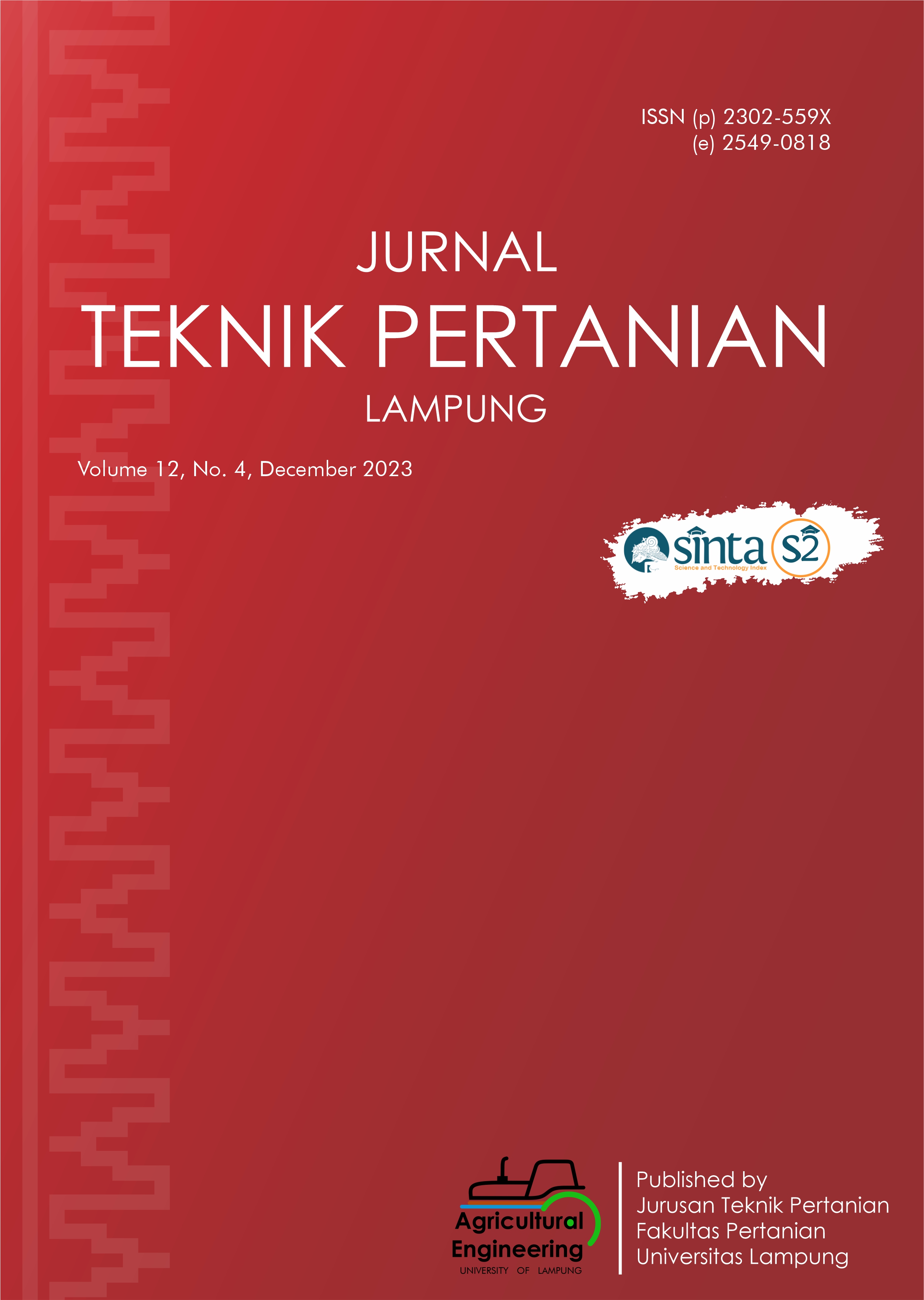Use of Portable Fluorescence Spectroscopy and SIMCA Method to Test The Authenticity of Apis mellifera Honey From Coffee Flower Nectar Mixed With Two Artificial Sweeteners
DOI:
https://doi.org/10.23960/jtep-l.v12i4.875-885Abstract
Honey with coffee flowers nectar is native honey formed from flower nectar. In this investigation, corn syrup and rice syrup, two artificial sweeteners, were utilized as an adulterant. Portable fluorescence spectroscopy and the SIMCA method are the tools and techniques employed. There were up to 20 samples of pure Apis mellifera honey and up to 120 samples of mixed honey (MC), each used twice. Data on the emission spectra, which are excited at a wavelength of 365 nm, were measured over the wavelength range of 300-800 nm. To improve accuracy, sensitivity, and specificity, the original spectral data was altered using a number of pre-treatments. Pretreatment with the original data with smoothing moving average may accurately identify samples and provides 100% accuracy, sensitivity, and specificity. One of the steps of the SIMCA approach, the cumulative PC, has a value of 92%, which indicates that it well explains the variation of the data. The x-loading plot's values are near the peak of the waves at 378 and 460 nm, indicating the existence of phenolic and flavonoid chemicals at those wavelengths.
Keywords: Apis mellifera honey, Corn syrup, Rice syrup, Portable Spectroscopy, SIMCA.
References
Apratiwi, N. (2016). Studi Penggunaan UV-VIS Spectroscopy untuk Identifikasi Campuran Kopi Luwak dengan Kopi Arabika. [Undergraduate Thesis]. University of Lampung.
Apriani, D., Gusnedi, G., & Darvina, Y. (2013). Studi tentang nilai viskositas madu hutan dari beberapa daerah di Sumatera Barat untuk mengetahui kualitas madu. Pillar of Physics, 2, 91-98
Aulia, A. S. (2022). Penggunaan UV-VIS Spektroskopi dan Metode Kemometrika Untuk Mengidentifikasi Pemalsuan Madu Monoflora (Acacia mangium) Lebah Tanpa Sengat (Heterotrigona itama) Dengan Bahan Pemanis HFCS-55. [Undergraduate Thesis]. University of Lampung.
Baroni, M.V., Podio, N.S., Badini, R.G., Inga, M., Ostera, H.A., Cagnoni, M., Gautier, E.A., GarcÃa, P.P., Hoogewerff, J., & Wunderlin, D.A. (2015). Linking soil, water, and honey composition to assess the geographical origin of Argentinean honey by multielemental and isotopic analyses. Journal of Agricultural and Food Chemistry, 63(18), 4638–4645. https://doi.org/10.1021/jf5060112
Bayu, N. (2015). Identifikasi dan Autentikasi Meniran (Phyllanthus niruri) Menggunakan Kombinasi Spektrum Ultraviolet-Tampak dan Kemometrika. [Undergraduate Thesis]. Institut Pertanian Bogor.
BSN. (2018). SNI 8664-2018: Madu. Jakarta: Badan Standardisasi Nasional.
BSN. (2013). SNI 3544-2013: Sirup. Jakarta: Badan Standardisasi Nasional.
da Silva, P.M., Gauchei, C., Gonzaga, L.V., Costa, A.C.O., & Feitt, R. (2016). Honeiy: Cheimical composition, stability and autheinticity. Food Cheim, 196, 309–323. https://doi.org/10.1016/j.foodcheim.2015.09.051
Felim, J. (2021). Kajian Litelatur Deteksi Adulteran pada Madu dengan Analisis FTIR. [Undergraduate Thesis]. Universitas Katolik Soegijapranata.
Chin, N.L., & Sowndhararajan, K. (2020). A review on analytical methods for honey classification, identification and authentication. In V. de Alencar Arnaut de Toledo & E. Dechechi Chambó (Eds.), Honey Analysis—New Advances and Challenges. IntechOpen. https://doi.org/10.5772/intechopen.90232
de Santana, F.B., Mazivila, S.J., Gontijo, L.C., Neto, W.B., & Poppi, R.J. (2018). Rapid discrimination between authentic and adulterated andiroba oil using FTIR-HATR spectroscopy and random forest. Food Analytical Methods, 11, 1927–1935. https://doi.org/10.1007/s12161-017-1142-5
Hadi B.H., Fajar S., Jati R., & Rizka, D. (2017). Penentuan kadar polifenol ekstrak teh kemasan dengan metode remaserasi menggunakan spektrofotometri UV-Vis. Jurnal Ilmiah Farmasi Akademi Farmasi Jember, 2, 7–14. https://doi.org/10.53864/jifakfar.v2i1.16
Himawan, A.B. (2022). Studi Pencampuran Madu Tidak Bersengat (Tetrigona apicalis) Dengan Sirup Jagung HFCS 55 Menggunakan UV–VIS Spektroskopi Dan Metode SIMCA. [Undergraduate Thesis]. University of Lampung.
Lavine, B.K. (2009). Validation of classifiers. In Walczak, B., Tauler, R., and Brown, S. (eds.). Comprehensive Chemometric : Chemical and Biochemical Data Aarlysis. Elsevier, Amsterdam: 587–599. https://doi.org/10.1016/B978-044452701-1.00027-2
Markham, K.R. (1988). Cara Mengidentifikasi Flavonoid. Penerbit ITB, Bandung.
Parri, E., Santinami, G., & Domenici, V. (2020). Front-face fluorescence of honey of different botanic origin: A case study from Tuscany (Italy). Applied Sciences, 10(5), 1776. https://doi.org/10.3390/app10051776
Sobrino-Gregorio, L., Vilanova, S., Prohens, J., & Escriche, I. (2019). Detection of honey adulteration by conventional and real-time PCR. Food Control, 95, 57–62. https://doi.org/10.1016/j.foodcont.2018.07.037
Suhandy, D., & Yulia, M. (2019). Tutorial Analisis Data Spektra menggunakan The Unscrambler. Yogyakarta: Graha Ilmu.
Wang, X., Rogers, K. M., Li, Y., Yang, S., Chen, L., & Zhou, J. (2019). Untargeted and targeted discrimination of honey collected by Apis cerana and Apis mellifera based on volatiles using HS-GC-IMS and HS-SPME-GC–MS. Journal of Agricultural and Food Chemistry, 67(43), 12144–12152. https://doi.org/10.1021/acs.jafc.9b04438
Wulansari, D. (2018). Madu Sebagai Terapi Komplementer. Yogyakarta: Graha Ilmu.
Downloads
Published
Issue
Section
License
- Authors who publish with this journal agree to the following terms:
- Authors retain copyright and grant the journal right of first publication with the work simultaneously licensed under a Creative Commons Attribution-ShareAlike 4.0 International Lice that allows others to share the work with an acknowledgement of the work's authorship and initial publication in this journal.
- Authors are able to enter into separate, additional contractual arrangements for the non-exclusive distribution of the journal's published version of the work (e.g., post it to an institutional repository or publish it in a book), with an acknowledgement of its initial publication in this journal.
- Authors are permitted and encouraged to post their work online (e.g., in institutional repositories or on their website) prior to and during the submission process, as it can lead to productive exchanges, as well as earlier and greater citation of published work (See The Effect of Open Access).
Jurnal Teknik Pertanian Lampung

JTEPL is licensed under a Creative Commons Attribution-ShareAlike 4.0 International License.

